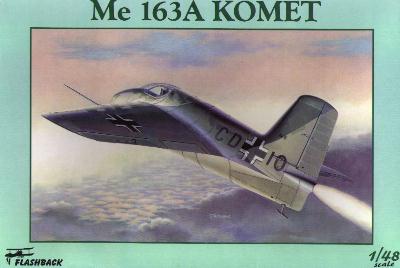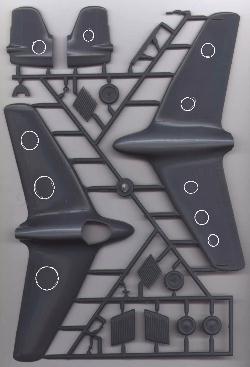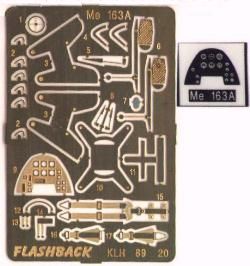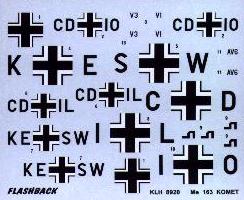Me 163 kits and accessories

The Flashback kit is the only injected kit in 1/48. A resin A&V Models Me 163A also exists, but I do not know any details of it. The images below bring you to two build reports. Note: none of the reports below mention the lack of leading edge slots. As far as I can tell, only KE+SW flew in this configuration, and possibly it too was modified later in the flight program. See the A.L. Bentley drawings for more information.

| 
|
| 'International Model News' article
| Fabrice Fanton's KE+SW
|
Other sites with information about this model:
In-the-box review
This review was written by Ruediger Landmann (Australia), with pictures and further comments by Ludo Kloek (Belgium).

The Flashback 1/48 kit is injection moulded with photoetched parts from Eduard and resin parts from Aires. The injection moulded parts consist of:
- Upper fuselage and wings (one piece)
- Lower fuselage and wings (one piece)
- Port and Starboard halves of fin, rudder, and rear fuselage (two pieces)
- Instrument panel
- Control stick
- Trim wheel
- Tail skid
- R4M rockets (two mouldings containing 12 rockets each)
- R4M racks (two)
- Take off dolly and two wheels (initial rigid version without dampers)
- Take off dolly and two wheels (improved version with damping)
The injection moulded parts (18 in total) are nicely done. Gates are fairly large and numerous, but the quality of the detail is very high indeed (the take-off dolly wheels are exquisite!). Panel line detail is very petite and is recessed. Too much sanding will make them disappear, so be careful. Comparison to plans and photos suggests that outline looks pretty good and panel lines seem to be in the right places. Unfortunetely, ejector pin marks mar many parts on the 'front' side. These are indicated by circles in the picture. But they should sand out without too much drama. A clear canopy is provided (injection moulded). It is suitably thin and transparent.

The photo-etched parts consist of:
- Trim wheel
- Actuators for Elevons, Rudder, and trimtabs
- Instrument panel face
- Cockpit levers and grab-handle
- Seatbelts
- Rudder pedals and bar
- Components for the heavy take-off dolly
The PE parts are very nice, but the cockpit levers will need a drop of
glue to make their knobs three-dimensional. A film is provided for the instrument panel. Lastly (not shown here) are two resin parts, consisting of the cockpit tub and the seat. The resin casting is
absolutely first class, delicate and crisp.

Decals are provided for three aircraft - KE+SW (the 163A prototype) and
two production machines: CD+IL and CD+IO. This latter aircraft is the one
in the famous photo with the R4Ms under its wings. "V" markings are
provided, being for "V1", "V3" and "AV6" respectively, with a decal
provided for each side of the fin. None of the published photos of KE+SW
(and there are many) show a "V1" marking on either side of the fin.
Furthermore, there is very strong evidence to suggest that this first
aircraft was coded V4 as a disinformation tactic. There is a photo of
three 163As (CD+IK, CD+IM, and CD+IO) on page 54 of the Profile
publications issue on the Me 163 (#225) that shows what appear to be
V-numbers painted on the fins, but unfortunately these are not legible.
What *is* evident, however, is that the marking on CD+IO is *not* "AV6" -
it's a "V" followed by two other characters, the first of which looks like
it might be a "0". A photo of CD+IL on page 52 of the same publication
shows no V number of the fin - but in this particular case, it could be
that the number is *just* out of frame. There is some doubt over the whole
question of these markings, then.
Notes:
I have to admit being a little bit wary of the parts breakdown, and wonder just how fine
(or otherwise!) those trailing edges are going to be. Similarly, the
practice of breaking the aircraft down into a top and bottom layer, and
then attaching the rear fuselage as left and right sides beings back bad
memories for how badly this arrangement worked on MPM's 1/72 J8M1 Shusui.
Who knows? Maybe Flashback's attempt will fit perfectly, but I'm
apprehensive...
It should also be noted here that the landing skid is also
represented only by a recessed outline on the underside of the fuselage,
meaning that if you want to show it extended, you've got to open up the
underside and then scratch the skid and its actuators by yourself. As far
as I know, this is another area of the 163A for which there is about zero
documentation, so perhaps it's just as well to leave it retracted! The
back of the kit box for Condor's 1/72 kit of this aircraft shows some
detail of the skid and of the tail skid as well, but I haven't been able
to match this with any published photos, suggesting that either Condor's
artist had access to photos that are not commonly available, or that these
views are somewhat speculative in nature.
The paint plan calls for a basic RLM02 finish for the whole aircraft. This
is generally accepted in the sources for the production 163As, but some
suggest RLM76 for KE+SW. Furthermore, it should be noted that KE+SW had
a very high gloss finish to it - possibly the aircraft was waxed to
coax a little more speed out of her. Turning now to one of the other
options, the famous photo of CD+IO shows irregular darker patches on the
aircraft's nose and leading edges. Some interpret this as being a darker
paint applied as camouflage (though how effective this would have been is
dubious), and others as a simple wearing of the paint. Flashback adopts
the latter opinion. The photo of CD+IO with the other two Me163As
mentioned above shows no evidence of these patches, but these photos were
taken a long time apart, so there would have been ample time for either
paint to be applied, or paint to flake off, depending on which explanation
you favour. It is clear however, that if you want to model this aircraft
with its rocket armament, you will need to apply the splotches anyway,
regardless of what they really were.
RLM02 is called out for the cockpit interior, the seat, and for the
instrument panel. I don't seem to have a picture of the seat, but RLM02
seems like a fair guess for the interior. The panel, however, is
considerably darker - RLM66 or perhaps even black. The cockpit floor also
seems to have been a darker colour than the rest of the interior. The
instructions also specify black for the whole control stick. However, only
the grip should be black. The body of the stick itself should be RLM02,
and the boot around its base is another light colour - perhaps a light
brown? The stick itself seems to be the wrong shape, the grip being
completely wrong, but this is easily replaced. At least the boot looks OK.
The instrument panel itself bears only a passing resemblance to the real
thing, which is a pity, since there's such an excellent photo of the panel
available. The instruments are in the wrong places, and the dial faces
represented on the film do not match the real instruments very well at
all. Based on the photo on page 48 of Ethell's book, there's a lot more
detail that could be added to the cockpit - but if you build the canopy
closed, I don't think that all that much will be visible. (Note that on
the 163A the canopy hinged upwards like on a modern fighter, not sideways
as on the 163B). The photo also suggests bright colours for the various
lever knobs, and this is consistent with what is found on 163Bs. On the
back of the box for the 1/72 Condor kit of the 163A, there's an artist's
impression suggesting some plausible reds and yellows. This is far from
definite, however, and anyone's guess is probably as good as anyone else's
here. It should be noted, however, that there are some major discrepancies
between this painting and the photo cited above that it is almost
certainly based on. Lastly, the seatbelts are called out as brown. Photos
of 163B pilots strapped into their aircraft suggest that this would have
to be quite a light brown indeed - more like a light tan, and certainly
not the shade suggested on the back of the Condor box.
Overall, looks like it'll build up nicely, but its disappointing that a
little more research didn't go into it to prevent some easily avoidable
errors. None of the sources I've cited have been particularly rare or
esoteric. On the other hand, with such an obscure subject, if you just
build it the way Flashback tells you to, only the Komet fanatics are going
to know the difference..
Return to Me 163 kits and accessories page





